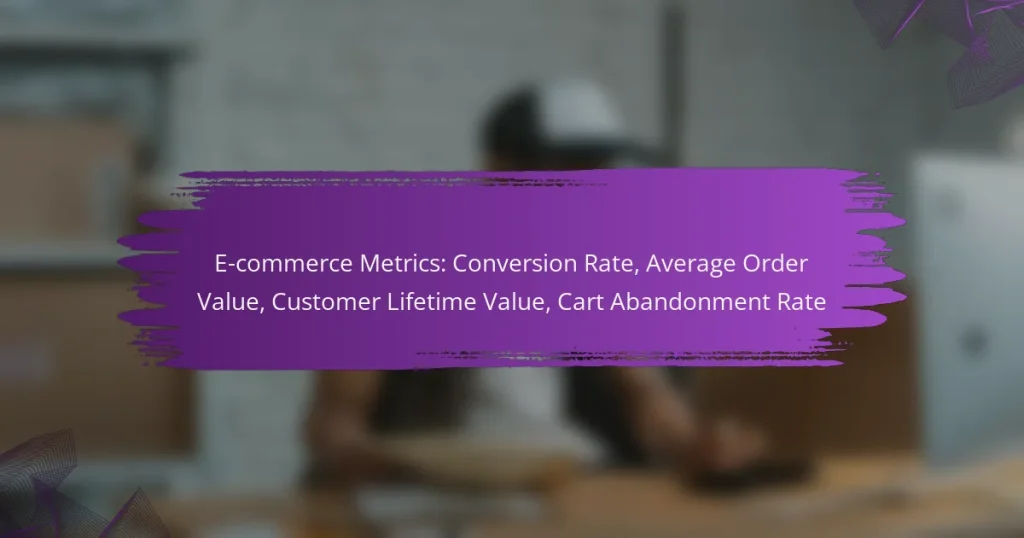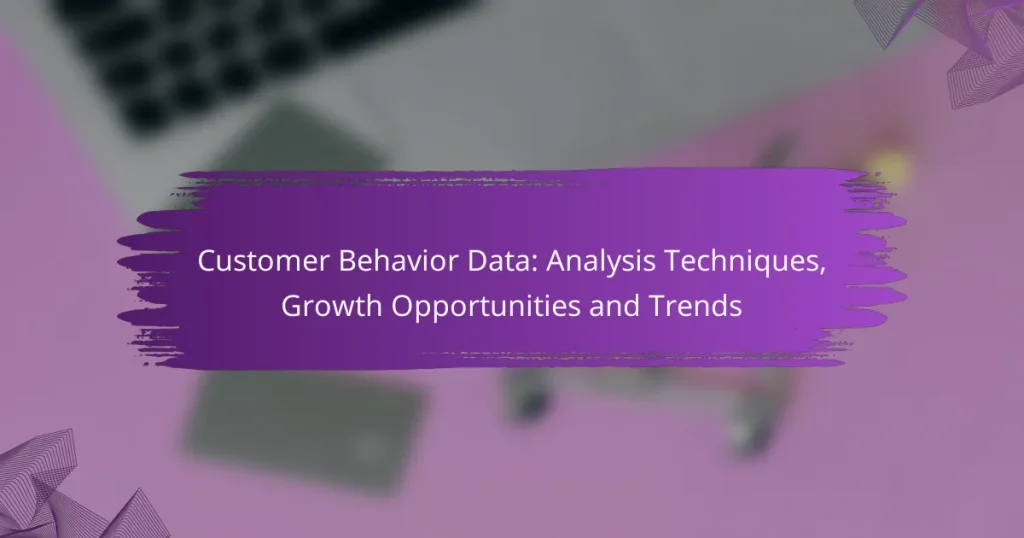E-commerce marketing solutions that utilize data analytics are essential for enhancing customer engagement and driving sales. By analyzing consumer behavior and preferences, businesses can create tailored marketing strategies that effectively meet customer needs and maximize returns. With various tools available, such as Google Analytics and Shopify Analytics, companies can gain valuable insights to optimize their marketing efforts.
E-commerce Metrics: Conversion Rate, Average Order Value, Customer Lifetime Value, Cart Abandonment Rate
E-commerce Dashboards: Key Metrics, Visualization Tools and Reporting
Predictive Analytics: Marketing Strategies, Customer Insights and Forecasting Techniques
Customer Behavior Data: Analysis Techniques, Growth Opportunities and Trends
What are effective e-commerce marketing solutions using data analytics?
Effective e-commerce marketing solutions leveraging data analytics involve strategies that utilize customer data to enhance marketing efforts, improve customer engagement, and drive sales. By analyzing consumer behavior and preferences, businesses can tailor their marketing approaches to meet specific needs and maximize returns.
Personalized marketing campaigns
Personalized marketing campaigns use data analytics to create targeted messages for individual customers based on their past behaviors and preferences. This approach can significantly increase engagement rates, as customers are more likely to respond to offers that resonate with their interests.
To implement personalized campaigns, businesses can utilize customer purchase history, browsing behavior, and demographic data. For example, an online clothing retailer might send tailored recommendations based on previous purchases, enhancing the shopping experience and encouraging repeat visits.
Predictive analytics for customer behavior
Predictive analytics involves using historical data to forecast future customer behaviors, enabling businesses to anticipate needs and optimize marketing strategies. By analyzing patterns, companies can identify trends and make informed decisions about inventory, promotions, and customer outreach.
For instance, a subscription box service might analyze subscriber data to predict which products will be popular in upcoming months, allowing them to adjust their offerings accordingly. This proactive approach can lead to higher customer satisfaction and retention rates.
Dynamic pricing strategies
Dynamic pricing strategies adjust product prices in real-time based on various factors such as demand, competition, and customer behavior. This data-driven approach allows e-commerce businesses to maximize revenue by offering competitive prices while responding to market changes.
For example, an airline might use dynamic pricing to adjust ticket prices based on seat availability and booking trends. By analyzing data, they can offer discounts during low-demand periods and increase prices when demand is high, optimizing their revenue potential.
Customer segmentation analysis
Customer segmentation analysis involves dividing a customer base into distinct groups based on shared characteristics, such as purchasing habits, demographics, or preferences. This segmentation allows businesses to tailor their marketing strategies to specific audiences, improving effectiveness.
For instance, a cosmetics brand might segment its customers into groups like skincare enthusiasts, makeup lovers, and budget shoppers. By understanding the unique needs of each segment, the brand can create targeted campaigns that resonate more deeply with each group, leading to higher conversion rates.
Performance tracking and optimization
Performance tracking and optimization involve continuously monitoring marketing efforts and analyzing their effectiveness using data analytics. This process helps businesses identify what works and what doesn’t, allowing for timely adjustments to strategies.
Key metrics to track include conversion rates, customer acquisition costs, and return on investment (ROI). For example, if a particular ad campaign is underperforming, data analysis can reveal insights into why it’s not resonating, enabling marketers to refine their approach for better results.
How can data analytics enhance customer engagement in e-commerce?
Data analytics enhances customer engagement in e-commerce by providing insights into customer behavior and preferences. By leveraging this information, businesses can tailor their marketing strategies to meet customer needs more effectively.
Real-time customer insights
Real-time customer insights allow e-commerce businesses to understand customer interactions as they happen. This can include tracking website visits, product views, and purchase patterns, enabling immediate adjustments to marketing strategies.
For example, if a sudden spike in traffic is observed for a particular product, businesses can quickly promote that item through targeted ads or social media campaigns. Utilizing tools like Google Analytics can help in gathering and analyzing this data efficiently.
Behavioral targeting techniques
Behavioral targeting techniques involve analyzing customer data to deliver personalized marketing messages based on past behaviors. This can include recommending products that align with previous purchases or browsing history.
Implementing these techniques can significantly increase conversion rates. For instance, using algorithms that suggest items based on similar customer profiles can enhance the shopping experience and encourage repeat purchases.
Automated email marketing
Automated email marketing utilizes data analytics to send personalized emails at optimal times, based on customer behavior. This approach can include cart abandonment reminders, personalized product recommendations, or follow-up emails after a purchase.
By segmenting email lists based on customer data, businesses can ensure that their messages resonate with specific audiences. Tools like Mailchimp or Klaviyo can help automate these processes, improving engagement and driving sales.
What tools are available for data analytics in e-commerce marketing?
Several tools are available for data analytics in e-commerce marketing, each offering unique features to help businesses understand customer behavior and optimize their strategies. Key options include Google Analytics, Shopify Analytics, and Adobe Analytics, which provide insights into traffic, sales performance, and user engagement.
Google Analytics for e-commerce
Google Analytics is a powerful tool that tracks website traffic and user interactions. For e-commerce, it allows businesses to monitor sales, conversion rates, and customer demographics, providing a comprehensive view of performance.
To effectively use Google Analytics, set up e-commerce tracking to gain insights into product performance and customer journeys. Regularly review reports to identify trends and areas for improvement, such as high bounce rates or cart abandonment.
Shopify Analytics features
Shopify Analytics offers built-in tools specifically designed for online stores using the Shopify platform. It provides reports on sales, customer behavior, and marketing effectiveness, making it easier for merchants to make data-driven decisions.
Utilize Shopify’s dashboard to track key metrics like average order value and sales by channel. Consider leveraging the insights from customer reports to tailor marketing campaigns and improve user experience on your site.
Adobe Analytics capabilities
Adobe Analytics is an advanced analytics solution that provides deep insights into customer data and behavior. It allows businesses to analyze data across multiple channels, offering a holistic view of marketing effectiveness.
To maximize Adobe Analytics, focus on segmenting your audience to understand different customer profiles. Use its predictive analytics features to forecast trends and optimize marketing strategies accordingly. This can help in personalizing user experiences and increasing conversion rates.
What are the key metrics to track in e-commerce marketing?
Key metrics in e-commerce marketing include conversion rate optimization, customer acquisition cost, and customer lifetime value. Tracking these metrics helps businesses understand their performance and make informed decisions to enhance marketing strategies.
Conversion rate optimization
Conversion rate optimization (CRO) focuses on increasing the percentage of visitors who complete a desired action, such as making a purchase. To improve CRO, analyze user behavior through tools like A/B testing and heatmaps to identify areas for enhancement.
Common strategies include simplifying the checkout process, improving website speed, and ensuring mobile responsiveness. A well-optimized site can see conversion rates increase from low single digits to double digits, significantly boosting revenue.
Customer acquisition cost
Customer acquisition cost (CAC) measures the total cost of acquiring a new customer, including marketing expenses and sales efforts. To calculate CAC, divide total marketing costs by the number of new customers gained during a specific period.
A lower CAC indicates more efficient marketing. Businesses should aim for a CAC that is significantly lower than the customer lifetime value (CLV) to ensure profitability. Regularly reviewing and adjusting marketing strategies can help maintain a healthy CAC.
Customer lifetime value
Customer lifetime value (CLV) estimates the total revenue a business can expect from a single customer throughout their relationship. Understanding CLV helps businesses allocate marketing budgets effectively and identify high-value customer segments.
To calculate CLV, multiply the average purchase value by the average purchase frequency and the average customer lifespan. A higher CLV allows for greater investment in customer acquisition, as long as the CAC remains proportionate. Businesses should focus on enhancing customer retention strategies to maximize CLV.
What are the prerequisites for implementing data analytics in e-commerce?
To effectively implement data analytics in e-commerce, businesses need a solid foundation that includes the right infrastructure, trained staff, and seamless integration with existing marketing platforms. These elements ensure that data can be collected, analyzed, and utilized to enhance marketing strategies and drive sales.
Data collection infrastructure
A robust data collection infrastructure is essential for gathering relevant information from various sources, such as website traffic, customer interactions, and sales transactions. This may involve implementing tools like Google Analytics, CRM systems, or custom data warehouses that can handle large volumes of data efficiently.
Consider using cloud-based solutions that offer scalability and flexibility, allowing you to adapt as your business grows. Ensure that your data collection methods comply with local regulations, such as GDPR in Europe, to protect customer privacy.
Staff training on analytics tools
Training staff on analytics tools is crucial for maximizing the potential of data analytics in e-commerce. Employees should be familiar with the software used for data analysis, interpretation, and reporting, which can include platforms like Tableau or Power BI.
Invest in regular training sessions and workshops to keep your team updated on the latest features and best practices. Encourage a data-driven culture where employees feel empowered to make decisions based on insights derived from analytics.
Integration with existing marketing platforms
Integrating data analytics with existing marketing platforms is vital for creating a cohesive marketing strategy. This integration allows for real-time data sharing and analysis, enabling marketers to make informed decisions quickly.
Evaluate your current marketing tools and ensure they can connect with your analytics systems. Look for platforms that offer APIs or built-in integrations to streamline this process. A well-integrated system can enhance customer targeting and improve overall campaign effectiveness.
How does data privacy impact e-commerce marketing analytics?
Data privacy significantly affects e-commerce marketing analytics by limiting the data that businesses can collect and use for targeted marketing. Regulations like GDPR in Europe and CCPA in California impose strict guidelines on how personal information is handled, which can restrict data-driven marketing strategies.
Understanding data privacy regulations
Data privacy regulations are laws that govern how businesses collect, store, and use consumer information. Key regulations include the General Data Protection Regulation (GDPR) in the European Union and the California Consumer Privacy Act (CCPA) in the United States. These laws require businesses to obtain explicit consent from users before collecting their data and provide them with rights to access, modify, or delete their information.
Impact on data collection methods
Due to data privacy regulations, e-commerce businesses must adapt their data collection methods. For instance, companies may need to rely more on first-party data, which is information collected directly from customers, rather than third-party data obtained from external sources. This shift can lead to a more transparent relationship with customers but may limit the breadth of data available for analysis.
Strategies for compliant analytics
To ensure compliance with data privacy laws while still benefiting from analytics, e-commerce businesses should implement clear privacy policies and obtain user consent for data collection. Utilizing anonymization techniques can also help protect individual identities while allowing for valuable insights. Regular audits of data practices can identify potential compliance issues before they become problematic.




